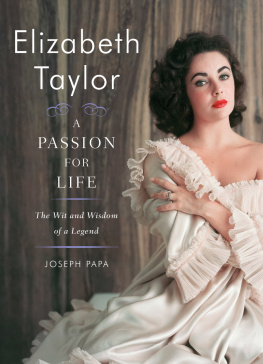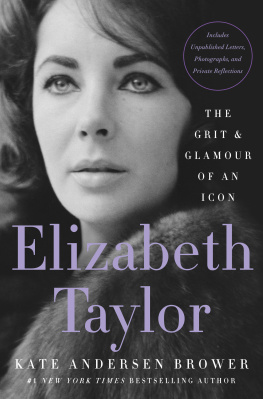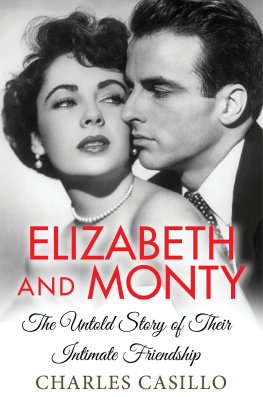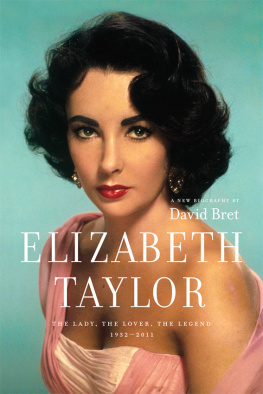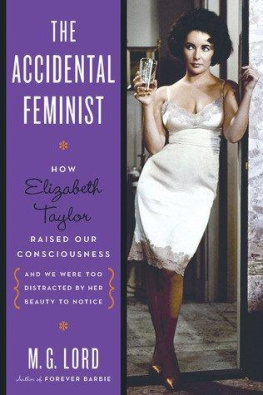Contents
I havent had a quiet life. Ive lived dangerously. Sometimes disaster has come at me like a train. There have been times when Ive almost drunk myself to death. Ive been in situations where I was perilously close to killing myself. Ive almost died several times. Yet some instinct, some inner force, has always saved me, dragging me back just as the train whooshed past.
Elizabeth Taylor
B road. Dame. Home-wrecker. The most beautiful woman in the world: It was never easy being Elizabeth Taylor, international movie star and femme fatale. A woman of seemingly contradictory passionsas extravagant as she was generous, and as gentle as she was poised for battleElizabeth was often misunderstood by her adoring audience, her family, and even, at times, by herself. Her outsize flair for living brought her to the brink of disaster time and time again as she tested the outer limits of her indulgences. Nothing, it seemed, from expensive jewelry to torrid love affairs, could satiate Elizabeths inner desires. It was only later in life, with her dedicated charity work, that Elizabeth found the peace and stability she sought so desperately.
But who was Elizabeth Taylor? On her own, away from the glare of the paparazzi, the adoring fans, and the many men who loved her, what made Elizabeth Taylors heart skip a beat? What inspired her sense of glamour, her steely inner core? To understand the elements that made Elizabeth tick, one must go back to her childhood. Her unique upbringing not only helped shape the woman she became, but also forecasted her future as one of Hollywoods most talented stars and uncompromising beauties.
Born in England in 1932 to a well-to-do American family with strong connections to the British upper class, Elizabeth was blessed with a beauty that made people stop and stare. Her mother, Sara, recognized Elizabeths alluring qualities and downplayed them, if only to emphasize the importance of personality and willpower over physical attributes. It was not until the Taylor family moved to Hollywood that Sara, a former stage actress, understood that Elizabeths beauty was a powerful calling card, one that gave the family a valuable entre into the industrys top-level studios and social circles. Sara dedicated her full attention to Elizabeth, priming her for a career in which she herself had achieved only modest success. Elizabeth learned, at an incredibly early age, that perfection in performance meant everything. She endured her mothers strict training as preparation for a life of greatness and reluctantly accepted the fact that there was little or no margin for error. The rebellious nature and wicked tongue that would later come to define Elizabeth Taylor may have been a reaction to the intense scrutiny she suffered as a child. It seemed that everyonefrom her perfectionist mother to the cadre of studio execs, agents, and audienceswere waiting and watching for Elizabeth to enter the full bloom of profitable womanhood. If there was ever a need to rebel, Elizabeth Taylor certainly had more than her share of reasons.
By the time she was twelve years old, Elizabeth boasted an impressive resum, having starred in Lassie Come Home and National Velvet . By the time she reached fifteen, she was an established star and, as she took on more adult roles, her costars were no longer dogs and horses, but some of Hollywoods most desirable leading men. In 1956, she starred opposite Rock Hudson and James Dean in Giant . That role firmly cemented her position as one of Hollywoods reigning actresses, and the hits that followed came in short order: Cat on a Hot Tin Roof (1958); Suddenly, Last Summer (1959); BUtterfield 8 (1960); and Cleopatra (1963). It was on the set of Cleopatra that Elizabeth met her greatest love, Richard Burton.
Elizabeth and Richard ruled over Hollywood for fifteen years, predecessors to the Brangelina and TomKat hysteria that sells the tabloids today. Elizabeths whirlwind affair with Burton defined scandal, captured the worlds attention and imagination, and brought condemnation from the Vatican. Their relationship was punctuated by every kind of excess imaginable, from booze to brawls to total sexual abandon. It was the kind of love Elizabeth craved. Full of larger-than-life highs and profoundly crippling lows, the relationship clearly wasnt perfect, yet that was part of its appeal. Having spent her whole life in the public eye, Elizabeth, at last, felt free. She followed her own rules and did what she pleased, relishing in complete ownership of her life. Though her health paid the price for her having lived so extravagantly for so long, she achieved what few among us ever do: the ability to experience everything life has to offer. In Cat on a Hot Tin Roof , Big Daddy Pollitt says, Ive got the guts to die. What I want to know is, have you got the guts to live? As if taking a cue from these lines, Elizabeth Taylor answers yes, again and again.
A fiercely private person despite her dramatic public outbursts, Elizabeth preferred to simply get down to the business of living her life instead of talking about it. Still, over her lifetime she imparted several gems of wit and wisdom that covered every subject: sex and scandal, beauty and humility, the importance of having a sense of humor, and the truth about dying. As a woman whod been through it all, she served as a model for living an inspired life and gave millions of women permission to follow their passions, even when conventional wisdom told them not to.
Here, then, is Elizabeth, uncensored, exactly as she would have wanted it.
I think I was probably born a ham.

Elizabeth, circa 1944.
Photofest
B efore she became one of the most legendary actresses of Hollywoods golden age, Elizabeth was just like any other girlwith violet eyes.
Although both of her parents, Francis Lenn Taylor and Sara Viola Warmbrodt, were from the American Midwest, Elizabeth Rosemond Taylor was born in a district of London called Hampstead, on February 27, 1932. The Taylors, including Elizabeth and her older brother, Howard, were comfortable in this semirural pocket of Londons northern edge. Francis was an art dealer, who had left the United States to start a gallery in London; her mother, Sara, was a former actress, who gave up her career when she married Francis.
Although the Taylors had strong connections to the theatre and art worlds, their approach to child-rearing was anything but bohemian. The Taylors were disciplinarians, emphasizing proper appearance and manners. For Elizabeth, this strict upbringing tempered her naturally precocious personality. When she did something wrong, she was sent to Coventrya form of British punishment whereby parents ostracized their disobedient children by not speaking to them. Ignoring Elizabeth was one way of wrestling withor perhaps encouragingher rebellious nature. Of course, Alexander Walker observes in his biography of Elizabeth, in those days, it didnt cost a film company millions to ignore Elizabeth Taylor. Despite her parents attempts to keep their daughter from getting too much attention, it wasnt long before Elizabeth found a wider audience.
When Elizabeth was four years old, she, along with several other children, performed at a benefit dance recital for the Duchess of York (the wife of George VI and the future queen mother) and her two daughters, the future Queen Elizabeth II and Princess Margaret, at the Hippodrome, a theatre in London. At curtain call, Elizabeth, dressed as a butterfly, curtsied to the royal partyand continued fluttering around the stage until her mother was finally forced to retrieve her. As Sara declared later, I knew from the benefit recital that Elizabeth had inherited a certain amount of ham. The incident became a part of the myththe genesis storyof Elizabeth Taylor, movie star. At the very least, this childhood anecdote foretold her future as an actress who was never shy at demanding attentionboth in her public and private lifeand who was able to hold an audience captive, on screen and off.

